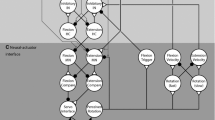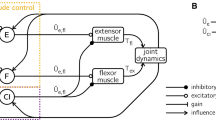Abstract
It is unknown precisely how the nervous system of invertebrates combines multiple sensory inputs to calculate more abstract quantities, e.g., combining the angle of multiple leg joints to calculate the position of the foot relative to the body. In this paper, we suggest that non-spiking interneurons (NSIs) in the nervous system could calculate such quantities and construct a neuromechanical model to support the claim. Range fractionated sensory inputs are modeled as multiple integrate-and-fire neurons. The NSI is modeled as a multi-compartment dendritic tree and one large somatic compartment. Each dendritic compartment receives synaptic input from one sensory neuron from the knee and one from the hip. Every dendritic compartment connects to the soma. The model is constructed within the Animatlab 2 software. The neural representation of the system accurately follows the true position of the foot. We also discuss motivation for future research, which includes modeling other hypothetical networks in the insect nervous system and integrating this model into task-level robot control.
Access this chapter
Tax calculation will be finalised at checkout
Purchases are for personal use only
Similar content being viewed by others
References
Buschmann, T., Ewald, A., Twickel, A. von, Büschges, A.: Controlling legs for locomotion - Insights from robotics and neurobiology. Bioinspiration and Biomimetics. 10, (2015). https://doi.org/10.1088/1748-3190/10/4/041001
Safavynia, S.A., Ting, L.H.: Sensorimotor feedback based on task-relevant error robustly predicts temporal recruitment and multidirectional tuning of muscle synergies. J Neurophysiol. 109, 31–45 (2013). https://doi.org/10.1152/jn.00684.2012.-We
Delcomyn, F., Nelson, M.E., Cocatre-Zilgien, J.H.: Sense organs of insect legs and the selection of sensors for agile walking robots. The International Journal of Robotics Research. 15, 113–127 (1996). https://doi.org/10.1177/027836499601500201
Gebehart, C., Schmidt, J., Büschges, A.: Distributed processing of load and movement feedback in the premotor network controlling an insect leg joint. J Neurophysiol. 125, 1800–1813 (2021). https://doi.org/10.1152/jn.00090.2021
Murray, R.M., Li, Z., Sastry, S.S.: A Mathematical Introduction to Robotic Manipulation. CRC Press (2017). https://doi.org/10.1201/9781315136370
Su, H., Qi, W., Yang, C., Aliverti, A., Ferrigno, G., de Momi, E.: Deep neural network approach in human-like redundancy optimization for anthropomorphic manipulators. IEEE Access. 7, 124207–124216 (2019). https://doi.org/10.1109/ACCESS.2019.2937380
Sandbrink, K.J., Mamidanna, P., Michaelis, C., Mathis, M.W., Bethge, M., Mathis, A.: Task-driven hierarchical deep neural network models of the proprioceptive pathway. https://doi.org/10.1101/2020.05.06.081372
Szczecinski, N.S., Hunt, A.J., Quinn, R.D.: A functional subnetwork approach to designing synthetic nervous systems that control legged robot locomotion. Frontiers in Neurorobotics. 11 (2017). https://doi.org/10.3389/fnbot.2017.00037
Szczecinski, N.S., Quinn, R.D., Hunt, A.J.: Extending the functional subnetwork approach to a generalized linear integrate-and-fire neuron model. Frontiers in Neurorobotics. 14 (2020). https://doi.org/10.3389/fnbot.2020.577804
Cofer, D., Cymbalyuk, G., Reid, J., Zhu, Y., Heitler, W.J., Edwards, D.H.: AnimatLab: A 3D graphics environment for neuromechanical simulations. J. Neurosci. Methods 187, 280–288 (2010). https://doi.org/10.1016/j.jneumeth.2010.01.005
Mamiya, A., Gurung, P., Tuthill, J.C.: Neural coding of leg proprioception in drosophila. Neuron 100, 636-650.e6 (2018). https://doi.org/10.1016/j.neuron.2018.09.009
Ache, J.M., Dürr, V.: A computational model of a descending mechanosensory pathway involved in active tactile sensing. PLoS Computational Biology. 11 (2015). https://doi.org/10.1371/journal.pcbi.1004263
Burrows, M.: Inhibitory Interactions Between Spiking and Nonspiking Local Interneurons in the Locust (1987)
Pearson, K.G., Fourtner, C.R.: Nonspiking Interneurons in Walking System of the Cockroach
Smarandache-Wellmann, C.R.: Arthropod neurons and nervous system (2016). https://doi.org/10.1016/j.cub.2016.07.063
Acknowledgements
This work was supported by NSF IIS 2113028 as part of the Collaborative Research in Computational Neuroscience Program. This work was also supported by NSF DBI 2015317 as part of the NSF/CIHR/DFG/FRQ/UKRI-MRC Next Generation Networks for Neuroscience Program.
Author information
Authors and Affiliations
Corresponding author
Editor information
Editors and Affiliations
Rights and permissions
Copyright information
© 2022 The Author(s), under exclusive license to Springer Nature Switzerland AG
About this paper
Cite this paper
Guie, C.K., Szczecinski, N.S. (2022). Direct Assembly and Tuning of Dynamical Neural Networks for Kinematics. In: Hunt, A., et al. Biomimetic and Biohybrid Systems. Living Machines 2022. Lecture Notes in Computer Science(), vol 13548. Springer, Cham. https://doi.org/10.1007/978-3-031-20470-8_32
Download citation
DOI: https://doi.org/10.1007/978-3-031-20470-8_32
Published:
Publisher Name: Springer, Cham
Print ISBN: 978-3-031-20469-2
Online ISBN: 978-3-031-20470-8
eBook Packages: Computer ScienceComputer Science (R0)




